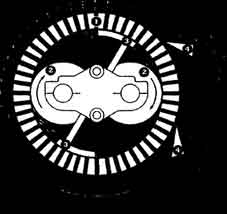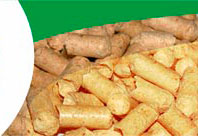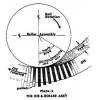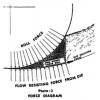How pellet mill works

From the conditioner, the feed is discharged over a permanent magnet and into a feed spout leading to the pelleting die.
Inter-elevator flights in the die cover feed the mash evenly to each of the two rolls.
Feed distributor flights (3) distribute the material across the face of the die.
Friction driven rolls (2) force the feed through holes in the die as the die revolves.
Cut-off knives (4) mounted on the swing cover cut the pellets as they are extruded from the die.
The pullets fall through the discharge opening in the swing door.
Figure 1.
Figure 2. shows a close up of one particular roller assembly and it's relationship to the
die.
Definitions- Reference Figure 2.
Roller Assembly., This is simply a cylinder idling on bearings in much the same manner
as the front wheel of a bicycle. The only driving force acting on the roller assembly is
the frictional turning force from the die, acting through a very thin layer of feedstock
between the die and the roll.
Die., The die is the rotating, driven component, utilizing the power applied to the pellet
mill. The die is composed of a ring of steel perforated with holes through which material
flows at pellet density. Perforation diameter and die thickness determine the final pellet
size and quality.
Feed., This is the material to be pelleted atter it has been properly conditioned for
extrusion.
Work Area., The work area in the pelleting chamber can be defined as that area where
the material is received at it's own density, compressed and then forced through the holes
in the die. In reality there are two supporting sections of the work area.
Compression Area,. Here the feed is compressed to near pellet density, forcing out the
entrained air, and forcing the individual particles into intimate contact with each other.
Extrusion Area., Here the feed has reached pellet density and is forced to flow through
the die holes.
It should be noted that this is not a continuous extrusion process, but in fact is
intermittent. As each die hole is driven underneath the roll a thin layer of feedstock is
forced into each hole.
As the process continues, each roll pass across the holes forces in another thin layer of
wood. The back pressure from die flow resistance then presses these thin layers together
to form a continuous extruded cylinder that becomes the final pellet.
Pellet Mill Forces., In order to fully understand how a pellet mill works, one must be
aware of the forces and how they are applied within the pelleting chamber. In particular,
one must look at the forces acting on a wedge of feed at the nip point of the pellet mill.
This is the heart of the process as illustrated on Figure 3.
There are three main forces to be considered in this analysis. Roll Force - The force from the roll acting on the material. This is the force that compresses the material and extrudes it through the die holes
Die Force - This is the force from the die that resists the flow of material through the
die holes. This force is designed into the system to produce the flow resistance or
back pressure that forces the individual feedstock particles together, where they bond
and form the pellet.
Slip Resisting Force - Finally there is a frictional force derived from the material contact
from the die. This particular force keeps the material from squirting along the face of the
die in front of the roll. This force is related to the pressure exerted by the roll and the
frictional characteristics of the feedstock itself.
The pressures generated in this process, as the wood is forced into the die holes, are quite
high. Experience shows that these pressures will vary between 20,684 to 44,800 +
newton per sq cm ( 30,000 and 65,000 + PSI ) depending on the characteristic of the
various wood species, feedstock preparation, moisture and the final pellet hardness
required for each specific pellet marketplace.
Any copying and distributing the material of Ukrainian Biofuel Portal
without active hyperlink is stricly prohibited !
Link to this news: How pellet mill works
Copy & Paste This Code to your website:
Views: 27562 Added: 03-07-2008
Average Rating:
How pellet mill works










